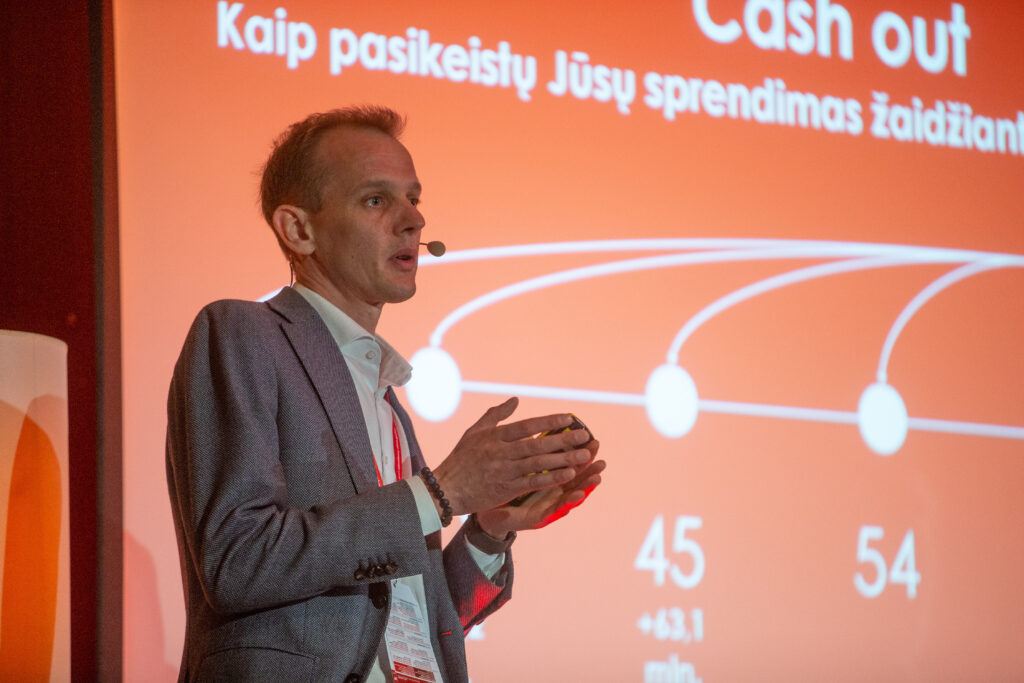Creditinfo Lithuania ISO27001 certified

Creditinfo Lietuva collects, stores and analyses information about the creditworthiness of businesses and individuals, assesses their credit history and assigns appropriate credit ratings. To meet the highest data security standards, the bureau introduced an ISO certified information security management system in 2014.
The system complies with the requirements of ISO/IEC 27001:2013 and is constantly reviewed, revised and subject to annual audits. On 26 April 2021, “Creditinfo Lietuva” successfully passed the periodical annual audit performed by “Bureau Veritas”.
The audit assessed the entire organization against 22 compliance criteria, including the competence and data security awareness of leadership and staff, information security management, business management procedures, sharing of responsibilities, management of documents, planning and control, activity monitoring and analysis, internal audit procedures, ability to swiftly resolve issues, continuous improvement, etc.
The audit also assessed the competence of employees of all levels, security of the information systems, IT and support, compliance of the information analysis and sales departments with the ISO requirements. The physical security and business policies of Creditinfo Lietuva were addressed by the audit as well.
The 2021 audit concluded that the information security management system of Creditinfo Lietuva meets the highest standards and can be considered a good practice. Data security in the company is given the highest priority, internal and external risks are constantly monitored and analyzed, and the company is prepared to address the risks in a professional manner.
Creditinfo analysis reveals Lithuanian textile industry severely hit by the pandemic

According to Creditinfo Lietuva, the textile industry of Lithuania is among the business areas which was hit by the pandemic extremely hard. In some sectors of the textile industry, the revenue is 30% below where it was before the pandemic, clothing manufacturers lost 11.7% and leather companies 31% of their employees. 17% of clothes making companies and 15% of textile manufacturers have been given high or very high bankruptcy risk scores.
“Textile industry, an extremely important business sector in Lithuania, is facing unprecedented challenges all over the world. Together with services, tourism and catering, the textile business has been suffering from a severe hit the consequences of which will persist for many more months to come”, says Aurimas Kačinskas, General Manager at Creditinfo Lietuva. “Unfortunately, there is little room for optimism in the immediate future of the sector, which means we‘ll have to keep business partners of the sector under a magnifying glass for quite some time”.
Further Downfall by 30% is Forecast if Global Lockdown Continues
A few days ago, “Coface” published its latest analysis of the global economy, where the economic forecast was downgraded only for the Central and Eastern Europe textile sector, while the textile industry itself, like global textile, was moved from high risk to the very high risk category. It means that no recovery or return to the pre-covid level is expected in textile industry until the end of the year. According to “Coface”, in the best-case scenario the decline of the textile industry will come to a halt at the end of the year, provided there are no new lockdowns introduced globally. If the countries worldwide continue imposing movement and social contact restrictions, this year will only see a further shrinking of the textile industry down to 30 percent of its volume in 2020, the year of hardship.
According to Statistic Department of Lithuania, the textile industry of Lithuania is made up of companies engaged in clothes making, textile manufacturing, leather processing and leather manufacturing businesses.
Employment at Leather Companies Plunged by 31 per-cent
According to Creditinfo, 949 companies reported textile-related activities as their core business last spring; there are 942 of such companies this year. Although the difference is slim, the true impact of the pandemic is revealed by the employment statistics. For instance, over the period of one year the number of employees at the clothes making companies dropped from 15,142 to 13,364 (11.7 per cent), and from 684 down to 472 (31 percent) at leather processing and leather manufacturing companies
Analysis conducted by Creditinfo revealed the revenue of textile manufacturing companies shrunk by 3.1 percent (from EUR 470.4 million to 455.8 million) compared with their revenue in 2019. The same trend was observed at the cloth making companies, where the revenue dropped by 19.9 percent from EUR 457.1 million down to 365.9 million, and leather processing and leather manufacturing companies with revenue going down by 30.2 percent from EUR 23.1 million to 16.2 million.
“We noticed that small and medium sized textile companies suffered the most, while large companies still had orders to fulfil”, says the CEO of the credit bureau. “Yet it is rather likely that the further shrinking textile market this year will reduce the number of orders for the large companies, too. It means that even more employees will be forced out of their jobs in the sector”.
1/6th of Companies with High and Very High-Risk Scores
According to the credit bureau, about 17% of cloth making companies and 15% of textile manufacturers currently are ranked as high bankruptcy risk companies.
“Earlier, the textile business was growing for quite some time, and so did the creditworthiness of the companies. Currently, the risk scores of textile companies brought them in line with problem sectors such as construction and transport”, Kačinskas explains.
Moreover, experts of the credit bureau noted, that only 25 percent of the companies in the textile industry submitted their financial statements for 2020. “It seems that only companies applying for subsidies or other pandemic-related reliefs submitted their financial statements as they were required to get the subsidies”, says Kačinskas. “We call upon all companies to declare their financial situation in time, as it will enable all market players to make more objective assessment of the textile sector, and help business partners to make more accurate decisions”.
For more information, please contact:
Aurimas Kačinskas, General Manager, Creditinfo Lietuva
Email: aurimas.kacinskas@creditinfo.lt
Tel: +37061810110
In boosting businesses, we could spurt like Ferraris, but we’re moving at Turtle speed

The analysis of the use of funds and current tendencies in the country’s economy leads to the obvious conclusion that we use the available financial resources in Lithuania in a too conservative way, and, instead of the opportunity to exploit the situation and spurt at the capacity of Ferrari, we choose a safe but a very slow growth at the speed of a Turtle.
From a psychological point of view, the situation is understandable, since along with the usual risks – commercial, technological and many others, business today faces the biggest challenge of regulation.
Recalling the lessons of 2009-2011 crisis, both business companies and banks more often ground the management of their economic situation on risk minimization. In other words, for reasons of caution, they would rather not grant a loan than allot time for a more thorough analysis of the situation.
However, a qualified and comprehensive risk management provide opportunities for business development, especially now, when we have a sufficient number of automated management tools based on data.
Several weeks ago, a survey carried out by the Bank of Lithuania (LB) showed that at the present moment, a more careful consideration should be given to hotels, restaurants, and part of real estate companies. However, the significantly reduced or discontinued funding has had a negative effect on an absolute majority of business sectors whose situation during the pandemic has not gotten worse and has even improved.
Capital adequacy is good, but a reluctance to lend money remains
Responsible lending constitutes the backbone of any economy, and Lithuanian business has learned to take a responsible attitude to loan repayments. For example, Lithuania is marked out among other countries of the European Union (EU) by the smallest – only 3% of all loan portfolio – part of business enterprises which have made use of a moratorium on loans declared in the spring of 2020.
In addition, according to the Bank of Lithuania, part of non-performing loans has been regularly decreasing and now has reached the lowest historical level of 1.5%. In other words, in their concern about high credit ratings and a good financial reputation, the enterprises are doing their utmost to repay both loans and interest on time.
With full knowledge of the aforementioned facts, what surprises, is a particularly prudent financing of business or strict conditions of granting loans, especially taking into account the fact that the population’s and enterprises’ deposits have reached record heights on a global scale. In Lithuania, the capital adequacy ratio of the bank sector having reached the highest bar of 25% in 2015, has remained at the top and currently fluctuates at around 22%.
The situation is changing dynamically, but every company must be evaluated separately
On the other hand, the analysis of the financial situation of enterprises warns that the situation in the market is changing dynamically. For example, if in 2020, 11% of enterprises entered the highest and high classes of bankruptcy risk, this year there are 17% of such enterprises. There is a greater probability that part of enterprises may fall behind on their payments. For example, in 2020 a high and the highest risk of payment delays was attributed to 18% of companies, however, this year the number of such enterprises has increased by 31%.
And still, the analysis of separate sectors provides more clarity. For example, the number of construction companies of high and the highest classes of risk has risen over the year from 19 % in (2020) to 23% in (2021). And in the transport sector from 15% to 23% respectively. A greater emphasis should be laid on the situation of trading companies. The companies of this sector have split into two blocs – companies whose activity was restricted and the financial situation was getting worse, and the ones whose situation was changing for the better.
Unfortunately, in the catering sector the situation is still the worst. Last year 30% of these companies were classified as having high or the highest risk, and this year this figure reached 45%. However, it is believed that a gradual loosening of business restrictions would enable the recovering of this sector.
The services sector is now doing well, – part of its enterprises of high and highest risk remains moderate, although it has increased by 6% to 9%. Every enterprise must be evaluated individually, and if the financial position and discipline are strong, there are no reasons for the discontinuation of financing such businesses.
We are living in many-speed economic conditions. When some enterprises are made to stop their activity, others experience a boom and have successfully moved their business to digital space. The EU business support measures have deferred the declaration of bankruptcy for part of enterprises. However, the situation can change even more dynamically when the states‘ support is withdrawn. This aspect makes one carefully supervise one‘s business partners, require quarterly financial reports, a record of the quality of transparent property and its declaration.
What rules would I most recommend to comply with? The enterprises which have the experience of assessing their partners, know that information in credit bureau systems which is updated every day, includes tens of various indicators, and algorithms which calculate creditworthiness and risk, evaluate more than 100 different parameters. However, at present, in evaluating the new partners‘ financial statements, activities or shareholders‘ business relationships, I would suggest paying particular attention to negative information. Check if there are no court actions, if the number of employees has not drastically decreased, and if there are no recorded arrears. Under the conditions of big flow of information your business could be assisted by an early warning system which would allow to see the threatening changes and thus, react immediately.
We have a sufficient number of tools of risk management, it is time to make a more efficient use of capital
Current technological innovations make it possible to both disclose and find information about the buyer‘s or partner‘s debts during a few seconds. Normally, the essential information about overdue payments is freely available. Therefore, I would urge again that every granting of credit should be considered separately. Evaluating the aforementioned figures, it becomes obvious that we have not used great possibilities to help economy recover as soon as possible. Guarding ourselves against a very small part of unreliable debtors, we punish a far bigger part of disciplined businesses.
An operative exchange of information about debtors could assist us and others in making more precise and quicker decisions as well as preventing a domino effect, when the debt of one enterprise establishes the whole chain of overdue payments.
Let us go back to strategies of a Turtle or Ferrari. There are different tools of risk management. It is possible to insure oneself against taking on any risk. In this case the enterprise will grow slowly.
Or, on the contrary, one can use all the capacities and possibilities of Ferrari. This car has not only fast acceleration and high speed, but also a well-operating brake system which in business, is analogous to data-based risk management.
There is no doubt that crediting must be responsible and take into consideration all the risks. However, at present there are enough reliable tools which assist in making optimal decisions. Therefore we can better employ capital, promote the country‘s business and stimulate its economy.
Jekaterina Rojaka,
Chief Commercial Officer,
Creditinfo Lithuania
Phone model, mobile internet and missed calls might determine whether you get credit

Press Release
Ever more personal data will in the future determine whether people can get a loan or buy goods on installment. If a person consents, before a decision is made about granting them credit they may be asked for permission to examine not just repayment of past loans but also other private information: what model of phone they have, whether they actively use mobile internet, whether they often do not answer calls. It may even be suggested that they play a real-time game whose outcome will determine whether they as a customer are creditworthy.
While companies that give credit have typically relied only on information gathered by financial institutions, now more and more personal data will influence decision-making. Whether credit is granted, how much, and on what terms may depend on whether a customer is ready to share that information.
“There’s no doubt that personal data can only be used with the person’s consent,” Creditinfo Head of Decision Analytics for the Baltic states, Maxim Fetisov immediately stresses. “But practice shows that openly sharing additional information increases a creditor’s trust, lets them more accurately assess each customer’s trustworthiness, and even allows customers to expect more favorable credit terms.” Research conducted by Creditinfo has shown that knowledge about a customer’s personal habits gives creditors just as many insights as formal data.
A recent conference “Scoring Kitchen” by Creditinfo, which rates the creditworthiness of companies and individuals in more than 50 countries, addressed what is new in the scoring process. For example, a study was done together with telco company on how people’s financial reliability relates to their everyday behaviour. Analysis of the data revealed that even how long people use one telecom operator’s services shows which ones are financially more trustworthy: the longer someone uses the same telco’s services, the more financially reliable their loan-payment history is too. And on the contrary, customers who frequently change operators generally demonstrated a higher level of riskiness.
Those without 4G and who use mobile internet little fall into a higher-risk group
Creditinfo analyst Allan Anyona, who took part in the study, also notes that individuals who are less financially reliable tend to have more modest internet plans and rush to connect as quickly as possible to free Wi-Fi networks at home and elsewhere.
Moreover, it was observed that the more advanced the network connection a potential customer’s phone supports, the greater their creditworthiness. So customers using phones that support 4G network requirements are seen more favorably than those whose phones only work on a 2G network or do not make such information available.
Many missed calls points to a frequent debtor
Creditors get useful insights as well from data about whether a potential customer often fails to answer incoming calls. People were divided into five categories: those who fail to answer calls very often, often, an average amount, rarely, and very rarely. It turns out the most financially reliable were those in the last two groups. The riskiest customers, meanwhile, were among the people who “miss” calls more often than others.
“We assume that people experiencing financial difficulties avoid answering calls as they do not want to talk with creditors or with relatives to whom they may also be in debt,” the Creditinfo Group analyst explains.
With smart devices revealing more and more information about consumers, creditors are eager to actively look at other habits too – like the use of a mobile wallet. The more punctually a customer tops up their mobile wallet limit and the bigger their income, the higher their credit rating will be. Conversely, the smaller someone’s income is and the longer they use credit provided by a telco, the more cautiously other lenders will view them. So those people should not be surprised if they are not allowed to buy a more expensive item on installment or are refused a bigger credit limit on a payment card.
Games show how you will behave with real money
Seeking to get a more objective assessment of a customer’s creditworthiness and to automate the decision-making process, psychometric data are being used ever more actively. A future customer may be asked to play a quiz that takes 5-7 minutes. It may be a series of questions, like: how would you use an unexpected gift of €200 – would you spend it on entertainment or save it? Studies show that the customers who meet their financial obligations most responsibly tend to choose the answer ‘I would save it’ in the game, while the riskiest customers more often choose ‘I would spend it on entertainment’.
“We realize that over time skilled players learn to choose those answer that creditors view more favorably. But in calculating any individual’s rating, dozens of other factors are also assessed, like their insurance history, repayment of earlier loans, payment of utilities bills, and so on,” CEO of Creditinfo Lithuania, Aurimas Kačinskas notes.
The pandemic also altered how companies are rated – there are new factors
The CEO of Creditinfo Lithuania says the challenges of the pandemic in 2020 are also changing the rules for rating businesses. New factors have arisen that impact credit scores. For instance, a new indicator for the impact of Covid-19 has altered the current ratings of companies all over the world. It shows how the coronavirus pandemic has impacted every area of business (e.g., tourism, hotels, manufacturing, transport, etc.) and how companies’ creditworthiness relates to the geographic location of their operations, demand for the goods they produce, and possibilities for quickly recovering after restrictions and quarantine end. Businesses’ ratings are also heavily influenced by a ‘Collection’ indicator that reflects whether a company punctually settles with its creditors.
“We have no doubt that the new factors that are coming up will have an increasing significance for companies’ credit scores – in a time of economic turmoil, it’s very important for creditors to objectively assess every customer’s riskiness and make the most accurate decisions possible,” Maxim Fetisov, Head of Decision Analytics in the Baltics says.
-ENDS-
About Creditinfo
Established in 1997 and headquartered in Reykjavík, Iceland, Creditinfo is a provider of credit information and risk management solutions worldwide. As one of the fastest growing companies in its field, Creditinfo facilitates access to finance, through intelligent information, software and analytics solutions.
With more than 33 credit bureaus running today, Creditinfo has the largest global presence in the field of credit bureau and risk management, with a significantly greater footprint than competitors. For decades it has provided business information, risk management and credit bureau solutions to some of the largest, lenders, governments and central banks globally – all with the aim of increasing financial inclusion and generating economic growth by allowing credit access for SMEs and individuals.
For more information:
Media Contacts:
Caterina Ponsicchi,
Marketing Director, Creditinfo Group
Six Corporate Image Improvement Tips for CFOs

It is customary to assume that the reputation and image of a company is mostly a prerogative of the general manager and the marketing unit. Credit is also given to employees who are in direct contact with the customers, yet financial decision-makers mostly go unnoticed. In this article, I will share some ideas about the huge influence Chief Financial Officers may have on the good corporate image.
Players in Baltic Markets (Latvia, Estonia) and Iceland Measure Risk better, benefitting from Covid-19 Impact Score Developed by Creditinfo.

Credit providers need to understand how COVID crisis affected their counter-parties and customers in order to better manage risk exposure and reduce losses. Current scoring models are unable to fully answer these needs as they were developed on pre-crisis data and need time to adjust to new conditions.
The way leading to the ‘haven’ of Startups is grounded by Data Analysis

Lithuania‘s transformation to the startup-friendly country has been successful: last year the first “unicorn” appeared in the market, and the startup ecosystem at present includes over 900 enterprises which have the great potential for business development based on innovations. And yet, the general conception of the startups’ contribution to the country’s economy has remained stereotypical, as it is alleged that these are risky enterprises which rapidly emerge and dissolve, and that they create few workplaces. The latest analyses done by “Creditinfo” and “Startup Lithuania” reject these stereotypes.
New “Creditinfo CO” system reports on debtors’ debtors

Press Release
April 28, 2020. Creditinfo Lithuania today introduced the new debtor reporting system “Creditinfo CO”. The system will give businesses the ability to learn, free of charge and in one place, how many companies are late with payments to their debtors and for what total amount starting from lock down period caused by COVID-19. The aim is to provide businesses with useful information that can help them make decisions on a more informed basis – whether to negotiate with debtors on payment terms, prepare documents for an assignment of debt, or initiate a judicial recovery process. It is also worthwhile checking what length deferments and what size trade credits are being granted to business partners.
Keep an eye on Partners’ Payments, Lithuanian experts advise

The current situation in Lithuania compels businesses to regard its partners with a deeper mistrust. The enterprises face challenges of their survival – how to ensure the continuity of activities, reorientate its services, and not lose the clients. Even those businesses which have a sufficient number of clients, feel worried about whether their partners are still trustworthy and will make payments on time.
Creditinfo Lithuania‘s R&D project approved for EU funding
Creditinfo Lithuania together with partners received an approval for more than 430 thousand euros EU funding. Funding is allocated for research and innovation activities.




